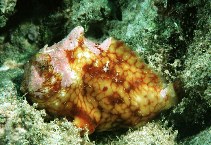| Family: |
Antennariidae (Frogfishes) |
| Max. size: |
9 cm SL (male/unsexed) |
| Environment: |
reef-associated; marine; depth range 0 - 73 m |
| Distribution: |
Indo-Pacific: East Africa (but apparently absent north of the Chagos Archipelago) to the Philippines and the Moluccas and eastward to island groups of the Pacific Plate. |
| Diagnosis: |
Dorsal spines (total): 3-3; Dorsal soft rays (total): 12-12; Anal spines: 0-0; Anal soft rays: 7-8. Illicium slightly longer than 2nd dorsal spine tapering to a non-filamentous simple tentacle that lacks an esca. Lacks a groove between the upper jaw and base of the illicium. Distinctive color pattern in which there is a broad dark band and marginal dark bands on the anal and caudal fins.
Description: Characterized by pale grey or yellowish color with dark brown to reddish brown reticular pattern; unbranched pelvic rays; third dorsal spine heavily covered by skin; presence of caudal peduncle (Ref. 90102). |
| Biology: |
Benthic species (Ref. 58302, 75154) found in inshore coral reef (Ref. 75154). The average depth for all known captures was 11.2 m. Individuals maintained in experimental aquaria change in color from dark gray to light cream within 2 weeks. Oviparous. Eggs are bound in ribbon-like sheath or mass of gelatinous mucus called 'egg raft' or 'veil' (Ref. 6773). Solitary and sometimes among hard coral branches (Ref 90102). |
| IUCN Red List Status: |
Least Concern (LC); Date assessed: 06 September 2021 Ref. (130435)
|
| Threat to humans: |
poisonous to eat |
Source and more info: www.fishbase.org. For personal, classroom, and other internal use only. Not for publication.
